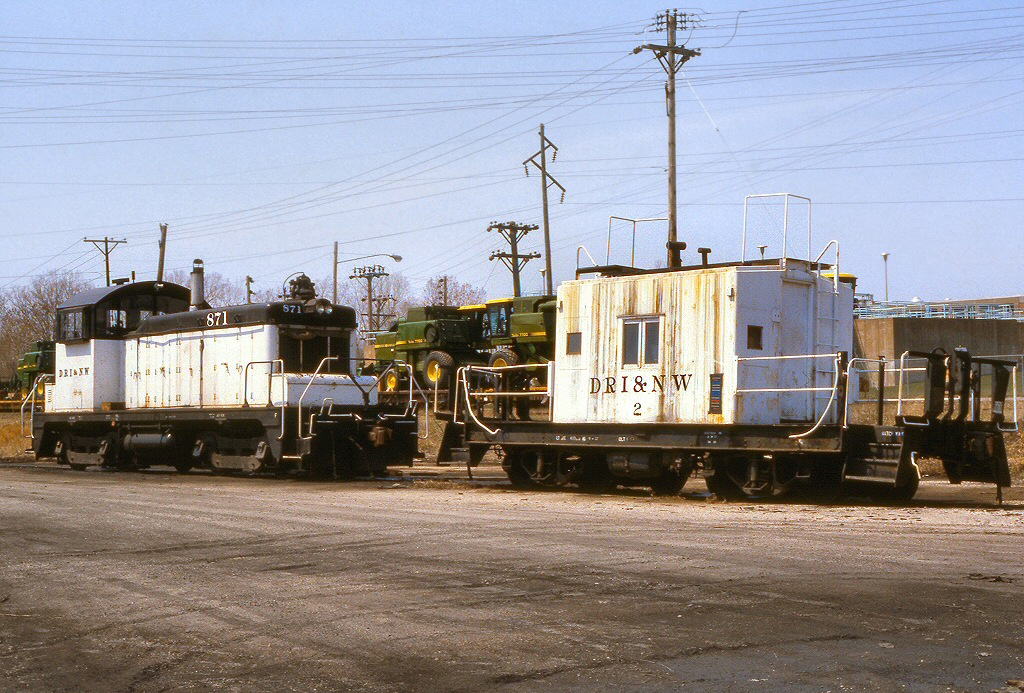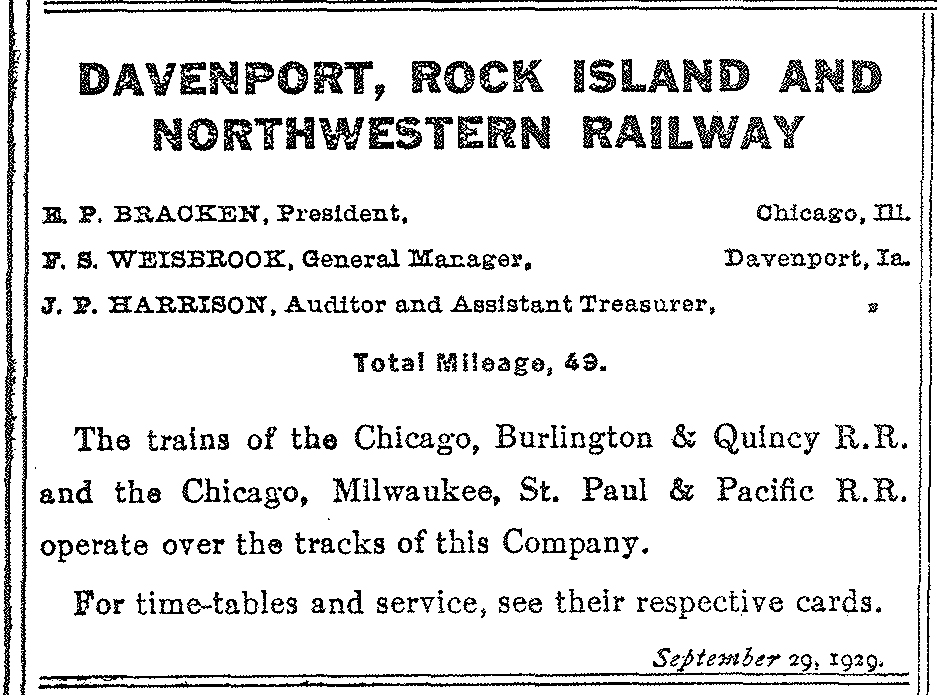Davenport, Rock Island and Northwestern Railroad
Last revised: November 20, 2024
By: Adam Burns
The Davenport, Rock Island and Northwestern Railroad (DRI&NW) is a fascinating example of a midwestern American short line that played a significant role in local transportation and economic development.
Established during the period of rapid railroad expansion in the United States, the DRI&NW served the Quad Cities region, which encompasses parts of Iowa and Illinois, straddling the Mississippi River.
Specifically, the system served Clinton and Davenport, Iowa with a connection across the Mississippi River into Rock Island and Moline, Illinois via the Crescent Bridge. The 48.5 mile line was jointly owned by the Milwaukee Road and Burlington. Following mergers and the industry's decline, the DRI&NW shutdown in 1995.
 DRI&NW SW1 #871 and a transfer caboose layover at the East Moline depot in April, 1980. Following the Rock Island's shutdown the DRI&NW took over the local switching duties of the Rock. Rob Kitchen photo.
DRI&NW SW1 #871 and a transfer caboose layover at the East Moline depot in April, 1980. Following the Rock Island's shutdown the DRI&NW took over the local switching duties of the Rock. Rob Kitchen photo.Early Beginnings
During the railroad industry's peak years through the mid-20th century there were numerous terminal lines - most located in the Midwest - serving large and medium-sized cities to provide switching and transfer work for both customers and the large Class 1s. In addition, many were owned by the big railroads themselves.
Some of the most famous were names like the Indiana Harbor Belt; Elgin, Joliet & Eastern; and Indiana Harbor Belt while less known systems included the Detroit & Toledo Shore Line; Peoria & Pekin Union; and Des Moines Union Railway.
The Davenport, Rock Island & Northwestern Railroad could best be described as the latter. It was conceived in the late 19th century, a time when railroads were burgeoning across America, fostering economic growth and connectivity.
The need for efficient transportation of goods and passengers between Clinton, Davenport and Rock Island prompted local business leaders and entrepreneurs to establish a dedicated rail line.
The DRI&NW was formally incorporated in Iowa on February 26, 1884 as the Davenport and Rock Island Railway Bridge Company for the purpose of building a bridge between Davenport, Iowa and Rock Island, Illinois.
To begin construction in both states the Davenport, Clinton & Eastern Railway was incorporated on April 11, 1885 to build in Iowa and the Rock Island & Eastern Illinois Railway was incorporated on May 9, 1886 to build in Illinois.
Operational Challenges and Innovations
The Crescent Bridge, an engineering marvel for its times, opened in 1899. The Davenport, Rock Island and Northwestern Railway acquired all of the above parties on July 30, 1901. All of this, of course, was simply for accounting purpose as the entire operation was jointly funded and controlled by the Chicago, Burlington & Quincy and Chicago, Milwaukee & St. Paul (Milwaukee R0ad).
In addition, the Rock Island enjoyed trackage rights between Nahant Yard (Davenport) and Clinton.
The DRI&NW's purpose throughout its corporate history was to provide a crucial link for freight traffic as well as provide switching/terminal services for the parent roads. The early 20th century brought both opportunities and challenges for the DRI&NW. The advent of the automobile and the increasing popularity of road transport presented competition to the railroad industry.
The railroad's ability to innovate was exemplified during World War I and World War II. The demand for efficient transportation of war materials and supplies saw the DRI&NW playing a vital role in supporting the national war effort. The railroad's robust infrastructure and strategic location made it a critical asset in the logistics network, underscoring its importance to regional and national interests.
Postwar Era
Following the end of World War II, the DRI&NW, like many other American railroads, faced a shifting transportation landscape. The proliferation of highway infrastructure and the increasing dominance of the trucking industry began to erode the railroad's share of freight traffic.
The general industrial decline through the 1960s and 1970s particularly hurt the system. The Rock Island was liquidated in 1980 and the Milwaukee Road, following its 1977 bankruptcy, was acquired by Soo Line in 1985.
Diesel Roster
| Model | Builder | Road Number | Serial Number | Completion Date | Notes |
|---|---|---|---|---|---|
| S-3 | Alco | 1 | 79532 | 12/1951 | Acquired by Birmingham Rail & Locomotive in 12/1975. Later sold to U.S. Agri Chemicals Corp. as #076. |
| S-3 | Alco | 2 | 79533 | 1/1952 | Acquired by Birmingham Rail & Locomotive in 12/1975. |
| S-3 | Alco | 3 | 80056 | 8/1952 | Acquired by Birmingham Rail & Locomotive in 12/1975. Later sold to I. Bork & Sons. |
| S-3 | Alco | 4 | 80057 | 8/1952 | Sold to Birmingham Rail & Locomotive in 12/1975. Later sold to Agrico Chemical Company as #4. |
| S-3 | Alco | 5 | 80292 | 9/1953 | Sold to Birmingham Rail & Locomotive in 12/1975. Later sold to Alexander Railroad as #6. |
| S-3 | Alco | 6 | 80293 | 9/1953 | Sold to Birmingham Rail & Locomotive in 12/1975. |
| S-3 | Alco | 7 | 80294 | 10/1953 | Sold to Birmingham Rail & Locomotive in 12/1975. Later sold to Celotex Corporation as #3. |
| SW1 | EMD | 84 | 900 | 6/1939 | ex-Burlington Northern #84l; built as CB&Q #9139 |
| SW1 | EMD | 86 | 1068 | 5/1940 | ex-Burlington Northern #86; built as CB&Q #9141 |
| SW7 | EMD | 107 | 10932 | 11/1949 | ex-Burlington Northern #107; built as Northern Pacific #107 (2nd) |
| SW1200 | EMD | 108 | 20052 | 12/1954 | ex-Milwaukee Road #611; built as Milwaukee Road #2059 (1st) |
| SW1200 | EMD | 109 | 18763 | 1/1954 | ex-Milwaukee Road #619; built as Milwaukee Road #1642 |
| SW7 | EMD | 121 | 8499 | 5/1950 | ex-Burlington Northern #121; built as CB&Q #9255 |
| SW1200 | EMD | 602 | 20043 | 12/1954 | ex-Milwaukee Road #602; built as Milwaukee Road #2050 (1st) |
| SW1200 | EMD | 613 | 20054 | 12/1954 | ex-Milwaukee Road #613; built as Milwaukee Road #2061 (1st) |
| SW1200 | EMD | 640 | 20070 | 11/1954 | ex-Milwaukee Road #640; built as Milwaukee Road #2035 (1st) |
| SW1 | EMD | 865 | 904 | 8/1939 | ex-Milwaukee Road #865/962 (2nd); built as Milwaukee Road #1612 |
| SW1 | EMD | 871 | 1049 | 4/1940 | ex-Milwaukee Road #871/#959/#968 (1st); built as Milwaukee Road #1623 |
Legacy
By then, the system was owned by the Soo and CB&Q successor Burlington Northern. In 1997 Soo Line successor Canadian Pacific sold off its interest to the newly formed I&M Rail Link, which was subsequently acquired by the Iowa, Chicago & Eastern on July 31, 2002 (a Dakota, Minnesota & Eastern subsidiary).
Things came full circle in 2008 when Canadian Pacific required DM&E/IC&E on October 30, 2008 and the former DRI&NW's main line has been a crucial link in the CP system ever since.
The Davenport, Rock Island and Northwestern Railroad stands as a testament to the transformative power of railroads in America's history. From its inception in the late 19th century to its adaptation and modernization in the face of changing transportation trends, the DRI&NW has left an indelible mark on the communities it served.
The railroad's story is one of innovation, resilience, and community impact. It highlights the interconnectedness of transportation, economic growth, and social development. The legacy of the DRI&NW will remain a source of pride and inspiration for the Quad Cities region and beyond.
Recent Articles
-
Oregon Railroad Museums: A Complete Guide
Apr 25, 25 03:11 PM
With its rich tapestry of scenic landscapes and profound historical significance, Oregon possesses several railroad museums that offer insights into the state’s transportation heritage. -
North Carolina Railroad Museums: A Complete Guide
Apr 25, 25 02:56 PM
Today, several museums in North Caorlina preserve its illustrious past, offering visitors a glimpse into the world of railroads with artifacts, model trains, and historic locomotives. -
New Jersey Railroad Museums: A Complete Guide
Apr 25, 25 11:48 AM
New Jersey offers a fascinating glimpse into its railroad legacy through its well-preserved museums found throughout the state.


